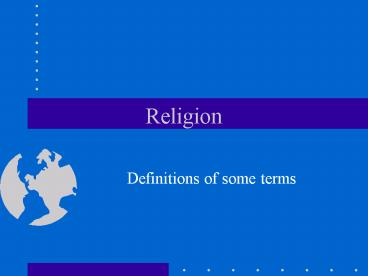Religion - PowerPoint PPT Presentation
1 / 26
Title: Religion
1
Religion
- Definitions of some terms
2
Definitions
- Sacrifice
- Myth
- Rituals
- Rites of Passage
- Ancestor Veneration
- Animism
- Magic
- Divination
- Taboo
- Totems
3
Animism
- It is the idea that the world and everything in
it is filled with souls or spirits. - These spirits can be communicated with.
- Spirits feel and therefore, can be harmed,
flattered, offended and can also hurt or help.
4
Magic
- Magic is a way of controlling the natural
elements. - Magicians attempt to control the elements for the
benefit of their society or for the detriment of
their enemies. - Nature is understood to be controlled by forces
which can be manipulated. - There is also sympathetic magic or imitative
magic.
5
Sympathetic magic
- A person attempts to get nature to do something
by performing the act oneself. - Examples
- a voodoo doll
- temple prostitutes
6
Divination
- Predicting the future.
- A person, shaman or priests, is especially
trained for this function.
7
- It may examine the entrails of a sacrificed
animal or watching flights of birds or palm
reading. - Tarot cards, Ouija boards are also examples of
divination.
8
Taboo
- Taboos are best viewed by those inside of the
tradition as ways of protecting the individual
from harm. Certain activities are avoided in
order not to offend the spirits. The word taboo
comes from the Polynesian word Tabu or tapu. In
early societies holy persons, objects and places
are considered off limits to ordinary folk.
9
Taboos (cont.)
- "Chieftains, priests, sacred places, fetishes,
and so on are to be avoided by the unordained,
except on special occasions or when there is
special preparation." Taboos follow birth and
death rituals. Sometimes twins are considered
taboos as well as the body of certain dead
people. In some cultures women who are mensing
are considered taboo.
10
Totems
- Totems. The word totem is from the Ojibwa word
ototeman. It is an identification that the tribe
or clan or nation has with a certain animal, or
sometimes certain plants or the moon or the sun
or the stars. In many later societies "mascots"
take the place of totems.
11
Sacrifice
- Sacrifice is a common practice in many religions.
"People have offered sacrifices of nearly every
imaginable material to the gods, spirits, demons,
and ancestors. Most often, the sacrifices are
animals, which are slaughtered and then burned or
cooked and eaten before the gods." Sacrifice of
other kinds of objects occurs as well.
12
Sacrifice (cont.)
- Sacrificing as various meanings which depend on
the religion, context, location, time of year,
the individual sacrificing etc. In the sacrifice
there is the sense of communing between the one
sacrificing and the deity, gods, or spirits to
whom the sacrifice is made.
13
Myth
- The word myth often has three meanings.
- 1. something widely accepted but is really
false. - 2. Stories in early societies which tell of
heroic actions or forces of nature or gods or
goddesses. - 3. Primitive belief about nature and the
universe. Pre-scientific
14
Myth
- Myth does not here mean a story that is not
true. Rather, myth means a story that presents
in the form of a narrative the basic world view
of a society. (Ellwood)
15
Rituals
- Ritual. Every religion has ritual. These are
rites and ceremonies which could be simple or
complex and are best interpreted in their
original setting or context. Sometimes these
ritual reenact myths and stories. Priests and
lay people take part in them. They sometime
involve particular kind of attire, or a specific
location. They could be the reliving of an
important event.
16
Rituals (cont.)
- (E)veryday religious activity and practice are
significant because their primary purpose often
to place individuals, families, and groups in
right relationships with gods, ancestors, other
human beings, and nature. (Ellwood) - Rituals are ways in which these relationships can
be insured.
17
Rites of Passage
- Rites of passage are aids in the journey in life
and are very important. Important events such
birth, death, marriage, passage into adulthood
are commemorated with special ceremonies. - They can be the enactment of myths or mirror the
ideas of the groups with regard to a particular
phase in life.
18
Ancestor Veneration
- The elders have a high place in these traditions
and are sometimes venerated. Some believe that
death is just a transition to another phase of
life and therefore the spirits of the ancestors
are still active. - Sometimes these spirits are feared and people
take action to prevent them from returning from
their graves. - Other societies believe that deceased ancestors
can benefit the society and will make offerings
to them.
19
Deities
- Many Hues
20
Theism
- Agnosticism -- God cannot be known
- Atheism -- (not-God-ism) There is no God
21
- Deism -- God is absent
- Polytheism (many-gods-ism) -- There are many
personal gods each has control on various aspects
of life
22
- Henotheism There are many gods but one
restricts ones allegiance to one God
23
Theism (cont.)
- Pantheism (God-is-all-ism) -God is identical with
nature and the universe as a whole
- Panentheism (everything-in-God) -- Everything
ultimately exists in god
24
- Monotheism (one-God-ism) -- There is only one
supreme Being
25
Sources
- http//www.northerndong.com/images/gallery/mask.jp
g - http//www.hope-link.org/images/magic.jpg
- http//www.voodoowizardneworleans.com/voodoodolls/
images/unknowndoll_2.jpg - http//hops.ucsd.edu/jordan/scriptorium/gga/gga07
4.jpg - http//www.crystal-connection.com/divine.shtml
- http//members.aol.com/oldenwilde/pix/divination.j
pg - http//www.lostworldarts.com/images/taboo.jpg
- http//www.mentors.ca/totems.gif
- http//www.be.wvu.edu/divecon/econ/trumbull/cuba/p
ics/sacrifice.jpg - http//www.sla.purdue.edu/academic/idis/jewish-stu
dies/covr/images/sacrifice.jpg - http//www.ajisunteho.com/rituals/images/014.jpg
- http//www.northearth.com/images/rituals.jpg
- http//www.soulawakening.org/ceremo3.jpg
- http//www.macnabstearoom.com/China/M20Ancestors
20Shrine.jpg
26
More Sources
- http//www.tsatsastudio.org/web_pics_small/deities
.jpg - http//www.iskcon.net/ct/graphics/Deities20full.j
pg - http//www.webeffects-aus.com/quicksilversmagic/bo
okofmagic/deities.gif - http//www.toel.org.uk/timages/atheism.jpg
- http//www.nd.edu/jquinn/humanism/images/huxley.j
pg - http//baci.duluth.com/images/blackewe1.jpg
- http//www.polytheism.com/egypha.jpg
- http//www.polytheism.com/naturegod.jpg
- http//www.polytheism.com/hivish.jpg
- http//www.polytheism.com/isis1.jpg
- http//www.nexusdomain.org/religions/ZEUSKERAVNIOS
.jpg - http//www.ghsd.k12.mi.us/KLICK/members/Jessi/spac
epages/PLANETS.jpg - http//members.aol.com/Heraklit1/images/m100-sce.j
pg - http//www.hereinstead.com/sys-tmpl/nss-folder/1pi
ctures/mgodsmaller.jpg































